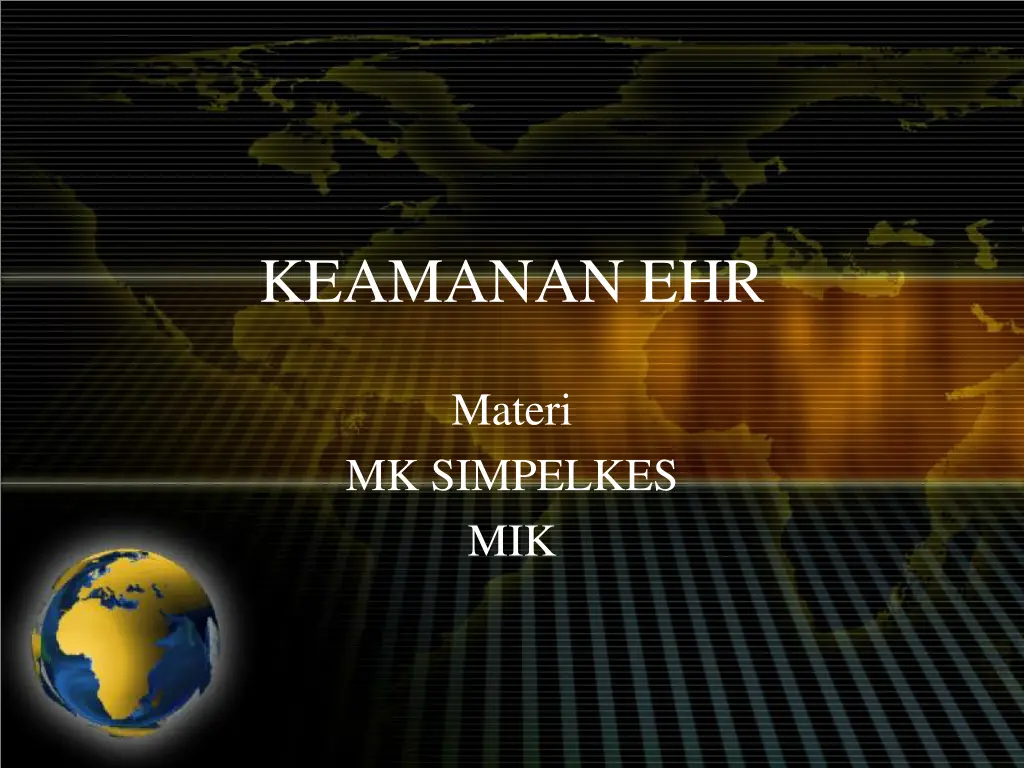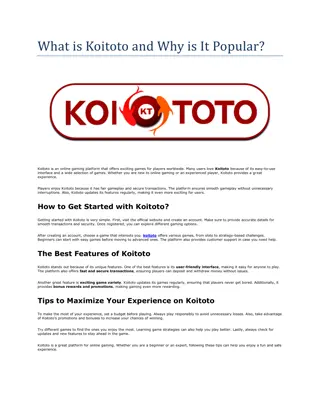
Ensuring Integrity and Confidentiality in Electronic Health Records (EHR)
Learn about the importance of integrity and confidentiality in Electronic Health Records (EHR) to maintain patient privacy, data accuracy, and access control. Discover the general principles, requirements, and key considerations for securing EHR systems effectively.
Download Presentation

Please find below an Image/Link to download the presentation.
The content on the website is provided AS IS for your information and personal use only. It may not be sold, licensed, or shared on other websites without obtaining consent from the author. If you encounter any issues during the download, it is possible that the publisher has removed the file from their server.
You are allowed to download the files provided on this website for personal or commercial use, subject to the condition that they are used lawfully. All files are the property of their respective owners.
The content on the website is provided AS IS for your information and personal use only. It may not be sold, licensed, or shared on other websites without obtaining consent from the author.
E N D
Presentation Transcript
KEAMANAN EHR Materi MK SIMPELKES MIK
GENERAL PRINCIPLES EHR Confidentiality: The patient s records are private and confidential; no unauthorized person may inspect the contents of the patient s records. Control: The patient controls the access to his or her records. A patient may grant access to an Health Provider (HP) and revoke such access rights when the treatment is over.
GENERAL PRINCIPLES Integrity: The patient s life may depend on the data contained in the records, and therefore only authorized people can enter or change the data. Legal Value: The patient s records are the unadulterated, complete record of all actions taken by the HPs on behalf of that patient and should be the definitive source of information about said actions.
REQUIREMENTS FOR AN EHR Integrity Issues As mentioned earlier, we believe that the integrity aspects of the EHR are the most important ones for its purpose, which is to provide the information to improve care quality, the possibility of economy, and the possibility of an oppor tunistic gain in quality. But in order to use the information, the HP must trust that the information is correct, complete, and up to date.
REQUIREMENTS FOR AN EHR The general principle of integrity is that no unauthorized person should be able to add, remove, or change any data in the EHR Availability The EHR must be available when the HP needs it. All care in making the system robust and redundant is necessary.
REQUIREMENTS FOR AN EHR Up-to-Datedness. The EHR must contain all the latest relevant information about the patient s health, so there should be no significant delay between when data is entered into the record and when it becomes available to a different HP. If an HP prescribes some medication to the patient, that information must be included in the EHR as soon as possible, so that if the patient consults another HP for some other reason, that information is available.
REQUIREMENTS FOR AN EHR Usability Although usability is not a integrity issue, it is also central to the correct use of the EHR: An HP should not need to read through all the patient s records to see that he or she has an allergy to Novocaine that was diagnosed 15 years ago during a dental appointment. All relevant, current health conditions, including allergies, must be easily accessible and presented in a clear way to the HP. Search facilities must also be provided to enable the HP to look for specific data in the patient s record.
REQUIREMENTS FOR AN EHR Confidentiality and Control Issues Confidentiality : the patient may expect that non authorized party will be able to read his or her medical records. Therefore, the storage and transmission of the EHR should be guarded by security measures that prevent eavesdropping. Control : that the patient can decide who should have access to his or her records and when this access is revoked. The patient grants an HP access to his or her EHR for a limited but not predefined duration. While that HP is treating the patient he or she has access the EHR, but as soon as the treatment is over, the HP s access to the records is closed.
No Automatic Access Rights to the Patient. The patient has no automatic right to read or change the EHR. The HP may delegate to the patient the right to read part of his own medical record, but such decision is a medical decision, one to which the HP may be ethically and professionally held accountable. This is a controversial principle that goes against the usually accepted requirements of electronic medical records and the usual understanding of ownership of the patient' medical record.
Emergency Access There are reasonable situations in which an HP may access a patient s record without his or her previous authorization. This is particularly clear in emergencies: If the patient comes to an emergency clinic unconscious or otherwise unable to grant access to his or her record, the responsible HP must be able to gain access to the records.
Implicit Acceptance of HO Structure By granting access to his or her EHR to an HO or HP, the patient implicitly accepts whatever access delegations are in place in the HO or whatever access delegations the HP defines. The HO and the HP may be criticized or punished for these delegations after the fact, but the patient cannot control who within the HO will have access, or what kind of access, to his or her EHR.
Limited Read Access for Public Health, Legal, and Professional Entities Some legal, public health, or professional bodies may have limited and anonymized read access to the EHR without the patient s approval. If an HP or HO is being investigated by a law enforcement agency or reviewed by a professional body, these bodies may have read access to anonymized segments of the HP s patients records that refer to the HP s (or HO s) decisions and actions, independent of the patients approval.
Legal Value Incrementability The EHR should be incremental; that is, information can never be removed or altered from the record, only added. Of course, there must be a mechanism to add corrections to the information already present. When presented to an HP, the record will show only the corrected version of the data, but as we will discuss later, the uncorrected version must be kept, along with the correction, who made it, and when.
Legal Value. Nonrepudiability One cannot deny making an entry in a patient s EHR. This is an important requirement for preserving the legal value of a record: If the record states that an HP decided on a particular therapy or made a particular diagnosis, the HP cannot deny that record.
Explicit Delegations In an HO, different professionals will enter different data in the patient s EHR. The identity of the person who entered the data, the person who delegated that right to the person, and so on should be clear in the record.
Recoverability of Specific Moments In order to verify the quality of an HP s decisions and actions, it is necessary to restore the EHR to the particular moment in time when the HP was performing the decisions and actions being reviewed. Therefore, the system must be able to show a snapshot of the EHR at that time, without the corrections and data entered after that moment.
Other Practical Considerations Right of a Record of One s Own Work The HP and the HO may have read access to an anonymized copy of the segment of the EHR that reflects their actions even if they no longer have access rights to the record.
Persyaratan keamanan E-medical HIPAA security memberikan syarat Memastikan kerahasiaan, integritas dan ketersediaan semua informasi kesehatan elektronik yang terlindungi dalam mengisi, menerima, perawatan dan transmisi. Sistem keamanan mengasumsikan segala kemungkinan antisipasi ancaman atau bahaya ataupun penyalahgunaan
TUJUAN Tujuannya yaitu memastikan cakupan asuransi kesehatan Mengurangi kecurangan dan penyalahgunaan. Mengimplementasikan administrasi yang sederhana untuk menjamin efektivitas dan efisiensi dari sistem pelayanan kesehatan. Melindungi informasi kesehatan individu dari akses oleh orang yang tidak berkepentingan.
HIPPA kebijakan keamanan dan tehnology ID yang unik untuk kewenangan pengguna Logoff otomatis Pelacakan jejak untuk akses pada informasi rahasia Encrytion (optional) Digital signature (optional) Prosedur cek virus Rencana back up Rencana recovery Program testing Program training
NETWORK Networks : informasi yang dipertukarkan antara unit pelayanan kesehatan rentan ditemukan melalui berbagai macam cara. Keamanan fisik mungkin akan mencukupi untuk lingkungan yang kecil. Pada lingkup yang besar dimana informasi kesehatan dipertukarkan antara jaringan publik, keamanan informasi harus dilengkapi dengan kriptogafy dan tehnologi keamanan.
APLIKASI Computer Operating System : Kebanyakan sistem operasi komputer modern menyediakan keamanan yang memadai untuk melindungi rekam medis. Bagaimanapun keamanan membutuhkan untuk dikonfigurasi berdasarkan kebijakan keamanan yang paling tepat. Konfigurasi termasuk menghapus account pengguna yang tidak terpakai dan tidak perlu dan memastikan bahwa semua password memenuhi standart kemananan. Software aplikasi : Sebagaimana sistem opersi, kebanyakan aplikasi modern mempunyai potensi untuk dikonfigurasi menjadi aman. Kebanyakan software aplikasi mempunyai keamanan yang lemah misalnya DBMS.
DATA Data : kebanyakan tipe informasi dapat dibaca dengan berbagai macam aplikasi (misal gambar). Keamanan akan gagal jika pengguna dapat berpindah aplikasi dengan kemananan yang rendah untuk membaca informasi. Kontrol akses harus diterapkan pada level dasar (file, database, dll) dimana data tersebut disimpan. Sebagai tambahan pada kasus informasi di dalam database keamanan harus diterapkan pada level dasar yaitu level data individu. Pada beberapa kasus informasi database juga membutuhkan perlindungan melalui beberapa form untuk kontrol akses pada field individu.
Tehnik membuat sistem e-medical aman Hal itu terbagi dalam tiga area yaitu aplikasi dan data, infrastruktur sistem dan jaringan.
TEHNIK KEAMANAN Kriptografi dasar. Otentikasi pengguna. : Otentikasi adalah proses verifikasi identitas dari pengguna potensial dari sistem. Kebanyakan mekanisme otentikasi berbasis pada kombinasi satu atau lebih tehnik misalnya password, alat keamanan (misal kartu akses) ataupun karakteristik fisik (misal sidik jari). Kombinasi yang umum (sering disebut two-factor authentication ) adalah berbasis pada apa yang kamu punya (misal kartu ATM) dan apa yang kamu tahu (misal ATM PIN). Paling sederhana adalah dengan menggunakan password ketika akan memasuki sistem. Otentikasi yang lebih canggih adalah penggunaan smart card atapun biometric seperti sidik jari, scan retina maupun scan wajah. Otentikasi tidak berarti kewenangan untuk mengakses segala informasi di dalam sistem akan tetapi hanya memverifikasi pada level berapa dapat mengakses informasi.
Kewenangan akses terhadap informasi yang bersifat rahasia: Akses kontrol seringkali disebut authorisasi adalah proses untuk memastikan bahwa pengguna mempunyai kewenangan mengakses sistem atau aplikasi. Akses ke bagian kecil informasi hanya dapat diajamin dengan otentikasi, kewenangan pengguna dengan berbagai level akses (misal dokter mungkin mempunyai akses penuh terhadap pasiennya tetapi hanya informasi statistika untuk pasien dokter lain.
Akuntabilitas untuk merubah informasi yang dilindungi : Pengguna dari kesehatan yang dilindungi dapat dipertimbangkan untuk semua akses , modifikasi dan distribusi informasi. Semua akses dari pihak yang tidak berwenang harus dilaporkan. Inspeksi rutin dari audit log adalah penting untuk melindungi keamanan dari sistem, integritas dari informasi rahasia dan legalisasi organisasi.
Integritas dari informasi terlindungi. Informasi kesehatan yang bersifat rahasia harus disajikan, disimpan dan didistribusikan dengan berbagai macam jalan dimana pihak yang berwenang ataupun tidak telah mengubah informasi dapat teridentifikasi dan terlacak. Sistem mempunyai mekanisme secara khas memberi batas yang erat kepada informasi dengan menyediakan penguat integritas sistem.
Non-repudiation : mekanisme penyangkalan menyediakan bukti yang tidak dapat disangkal dari membuat, menghapus, memodifikasi atau distribusi informasi. Hal ini memastikan tidak satupun pengguna dapat akses, merubah ataupun mendistribusikan informasi dan menyangkal telah melakukannya.
Confidentiality : Data dalam sistem yang aman atau data yang dipertukarkan antar sistem yang aman harus tidak terlihat oleh pengguna ataupun sistem yang tidak berwenang. Privacy sering harus diperluas sesuai permintaan untuk memastikan sistem aman. Pengguna yang tidak berwenang dapat berpotensi memperoleh informasi penting tentang data dalam sistem dengan sederhana overhearing permintaan data. Informasi yang bersifat rahasia seharusnya tidak disimpan dalam bentuk plain text dalam sistem yang tidak aman. Jika keamanan fisik elektronik dari sistem tidak mencukupi, informasi rahasia seharusnya dienskripsi dan tidak disimpan dalam sistem yang tidak aman.
Monitoring akses dan modifikasi informasi rahasia Tiap mekanisme keamanan digunakan untuk melindungi sistem dan informasi yang sensitif yang berpotensi untuk diserang. Untuk memelihara keamanan dan integritas dari informasi rahasia, dibutuhkan kebijaksanaan tidak hanya dalam pemilihan tehnology dan implementasi kebijakan tetapi juga dalam monitoring sistem untuk mengidentifikasi upaya pelanggaran seperti dugaan trend akses dan jejak dari pemenuhan kebiajkan dan prosedur. Monitoring melingkupi audit logs, analisis trends, alarm bahkan laporan.


